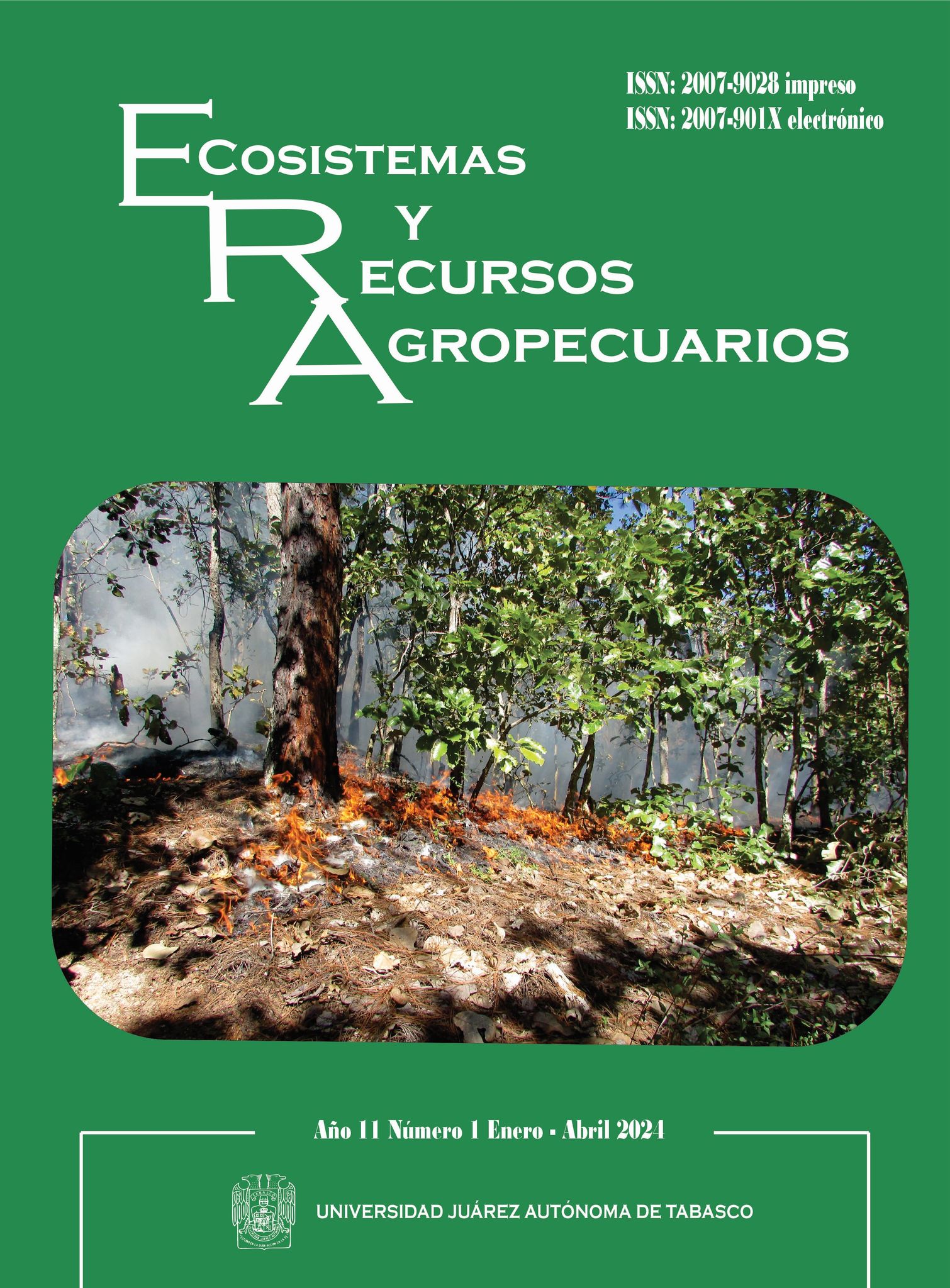Extracción de compuestos antioxidantes en sandía y melón en la Comarca Lagunera
DOI:
https://doi.org/10.19136/era.a11n1.3953Palabras clave:
Fenólicos, flavonoides, cucurbitácea, hortalizas, nutraceúticoResumen
La sandía y melón son hortalizas básicas. El objetivo fue estudiar sus propiedades antioxidantes en distintas partes de los frutos e identificar el mejor método de extracción para obtener compuestos activos. La cuantificación de compuestos fenólicos totales (CFT), flavonoides totales (FVT) y actividad antioxidante total por ABTS y DPPH se realizó por técnicas espectrofotométricas. Para CFT se obtuvieron valores de 4.4 y 48.1 mg AGE g-1para cascara de sandía y pulpa de melón, respectivamente. El FVT fue de 157 y 213 mg QE g-1 para las semillas de sandía y melón. La técnica de ABTS osciló entre 26147.6 para pulpa de melón y 9302.3 μM Trolox g-1 para cascara de sandía. Por DPPH la mayor actividad antioxidante fue en pulpa de melón (18989.5 μM Trolox g-1). El método de extracción más eficiente fue con muestras sometidas a calor destacando la extracción de semillas de sandía por su alto contenido antioxidante.
Descargas
Referencias
Ainsworth E, Gillespie K (2007) Estimation of total phenolic content and other oxidation substrates in plant tissues using Folin–Ciocalteu reagent. Nature Protocols 2: 875-877. https://doi.org/10.1038/nprot.2007.102
Armesto J, Rocchetti G, Senizza B, Pateiro M, Barba FJ, Domínguez R, Lorenzo JM (2020) Nutritional characterization of Butternut squash (Cucurbita moschata D.): Effect of variety (Ariel vs. Pluto) and farming type (conventional vs. organic). Food Research International 132: 109052. https://doi.org/10.1016/j.foodres.2020.109052
Baba S, Malik S (2015) Determination of total phenolic and flavonoid content, antimicrobial and antioxidant activity of a root extract of Arisaema jacquemontii blume. Journal of Taibah University for Science 9: 449-454. https://doi.org/10.1016/j.jtusci.2014.11.001
Bala S, Garg D, Sridhar K, Inbaraj BS, Singh R, Kamma S, Sharma M (2023) Transformation of agro-waste into value-added bioproducts and bioactive compounds: Micro/nano formulations and application in the agri-food-pharma sector. Bioengineering 10(2): 152. https://doi.org/10.3390/bioengineering10020152
Barbi RCT, Hornung PS, Avila S, Alves FEDSB, Beta T, Ribani RH (2020) Ripe and unripe inaja (Maximilia maripa) fruit: A new high source of added value bioactive compounds. Food Chemistry 331: 127333. https://doi.org/10.1016/j.foodchem.2020.127333
Brand W, Berset C (1995) Use of a free radical method to evaluate antioxidant activity. LWT - Food Science and Technology 28: 25-30. https://doi.org/10.1016/S0023-6438(95)80008-5
Bouaziz A, Djidel S, Bentaher A y Khennouf S (2020) Polyphenolic content, Antioxidant and Anti-inflammatory activities of Melon (Cucumis melo L. var. inodorus) Seeds. Journal of Drug Delivery and Therapeutics 10(2): 22-26. http://dx.doi.org/10.22270/jddt.v10i2-s.4022
Cakmakci S, Topdaş EF, Kalın P, Han H, Şekerci P, Polat-Kose L, Gulcin I (2015) Antioxidant capacity and functionality of oleaster (Elaeagnus angustifolia L.) four and crust in a new kind of fruity ice cream. International Journal of Food Science and Technology 50(2): 472–481. https://doi.org/10.1111/ijfs.12637
Dhen N, Rejeb IB, Martínez MM, Román L, Gómez M, Gargouri M (2017) Effect of apricot kernels flour on pasting properties, pastes rheology and gels texture of enriched wheat flour. European Food Research and Technology 243: 419–428.
Dhiman AK, Bavita K, Attri S, Ramachandran P (2018) Preparation of pumpkin powder and pumpkin seed kernel powder for supplementation in weaning mix and cookies. International Journal of Chemical Studies 6: 167–175.
Domínguez E, Ordoñez E (2013) Evaluación de la actividad antioxidante, vitamina C de zumos cítricos de lima dulce (Citrus limetta), limón tahití (Citrus latifolia), limón rugoso (Citrus jambhiri Lush). Investigación y Amazonía 3: 30-35.
Feizy J, Jahani M, Ahmadi S (2020) Antioxidant activity and mineral content of watermelon peel. Journal of Food and Bioprocess Engineering 3(1): 35-40. 10.22059/JFABE.2020.75811
Gade SR, Meghwal M, Prabhakar PK, Giuffrè AM (2022) A comparative study on the nutritional, antioxidant, thermal, morphological and diffraction properties of selected cucurbit seeds. Agronomy 12(10): 2242. https://doi.org/10.3390/agronomy12102242
Ganji SM, Singh H, Friedman M (2019) Phenolic content and antioxidant activity of extracts of 12 melon (Cucumis melo) peel powders prepared from commercial melons. Journal of Food Science 84(7): 1943-1948. https://doi.org/10.1111/1750-3841.1466
Gulcin İ (2020) Antioxidants and antioxidant methods: An updated overview. Archives of Toxicology 94(3): 651-715. https://doi.org/10.1007/s00204-020-02689-3
Ignat I, Volf I, Popa VIA (2011) Critical review of methods for characterisation of polyphenolic compounds in fruits and vegetables. Food Chemistry 126: 1821–1835. https://doi.org/10.1016/j.foodchem.2010.12.026
Ivanović M, Islamčević-Razboršek M, Kolar M (2020) Innovative extraction techniques using deep eutectic solvents and analytical methods for the isolation and characterization of natural bioactive compounds from plant material. Plants 9(11): 1428. https://doi.org/10.3390/plants9111428
Kumari J, Rao J, Kumari N, Sharma P, Jain V, Dave S, Sharma (2013) Analgesic activity of aqueous extract of Citrullus lanatus peels. Advances in Pharmacology and Pharmacy 1(3): 135-138. https://doi.org/10.13189/app.2013.010303
Mai Y, Zhuang Q, Li Q, Du K, Wu D, Li H, Gan R (2022) Ultrasound-assisted extraction, identification, and quantification of antioxidants from ‘Jinfeng’ kiwifruit. Foods 11: 827. https://doi.org/10.3390/foods11060827
Manivannan A, Lee ES, Han K, Lee HE, Kim DS (2020) Versatile nutraceutical potentials of watermelon-a modest fruit loaded with pharmaceutically valuable phytochemicals. Molecules 25: 5258. https://doi.org/10.3390/molecules25225258
Naguib DM, Tantawy AA (2019) Anticancer effect of some fruits peels aqueous extracts. Oriental Pharmacy and Experimental Medicine 19(4): 415-420. https://doi.org/10.1007/s13596-019-00398-6
Neglo D, Tettey CO, Essuman EK, Kortei NK, Boakye A A, Hunkpe G, Devi WS (2021) Comparative antioxidant and antimicrobial activities of the peels, rind, pulp and seeds of watermelon (Citrullus lanatus) fruit. Scientific African 11: 00582. https://doi.org/10.1016/j.sciaf.2020.e00582
Nenadis N, Tsimidou M (2002) Observations on the estimation of scavenging activity of phenolic compounds using rapid 1,1-diphenyl-2-picrylhydrazyl (DPPH) tests. Journal of the American Oil Chemists' Society 79: 1191–1195. https://doi.org/10.1007/s11746-002-0626-z
Omigie IO, Agoreyo FO (2014) Effects of watermelon (Citrullus lanatus) seed on blood glucose and electrolyte parameters in diabetic wistar rats. Journal of Applied Sciences and Environmental Management 18(2): 231–233. DOI: 10.4314/jasem.v18i2.12
Oroian M, Escriche I (2015) Antioxidants: Characterization, natural sources, extraction and analysis. Food Research International 74: 10-36. https://doi.org/10.1016/j.foodres.2015.04.018
FAOSTAT (2023). Organización para la Agricultura y la Alimentación, base de datos estadísticos corporativos https://www.fao.org/faostat/es/#data/QI. Fecha de consulta:_ 20 de enero de 2024.
Panda D, Manickam S (2019) Cavitation technology-the future of greener extraction method: A review on the extraction of natural products and process intensification mechanism and perspectives. Applied Sciences 9(4). https://doi.org/10.3390/app9040766
Reyes-Munguía A, Carrillo-Inungaray ML, Carranza-Álvarez C, Pimentel-González DJ, Alvarado-Sánchez B (2016) Antioxidant activity, antimicrobial and effects in the immune system of plants and fruits extracts. Frontiers In Life Science 9(2): 90-98. http://dx.doi.org/10.1080/21553769.2015.1104388
Rimando AM, Perkins-Veazie PM (2005) Determination of citrulline in watermelon rind. Journal of Chromatography A 1078(1–2): 196-200. https://doi.org/10.1016/j.chroma.2005.05.009
Robles-Robles MR, Jaime-Meuly R (2019) Characteristics and main effects of contract agriculture in La Costa de Hermosillo. Expert Journal of Economy 7(2): 66-74.
Rolim PM, Fidelis G, De Araújo P, Carlos E, Santos E, Rocha H, Macedo G (2018) Phenolic profile and antioxidant activity from peels and seeds of melon (Cucumis melo L. var. reticulatus) and their antiproliferative effect in cancer cells. Brazilian Journal of Medical and Biological Research 51(4): 1-14. https://doi.org/10.1590/1414-431X20176069
Septembre-Malaterre F, Remize P, Poucheret (2018) Fruits and vegetables, as a source of nutritional compounds and phytochemicals: changes in bioactive compounds during lactic fermentation. Food Research International 104: 86–99. https://doi.org/10.1016/j.foodres.2017.09.031
Servicio de Información Agroalimentaria y Pesquera (SIAP) (2023) Recuperado de https://nube.siap.gob.mx/avance_agricola/ el 20 de enero de 2024
Silva JS, Ortiz DW, García LGC, Asquieri ER, Becker FS, Damiani C (2020) Effect of drying on nutritional composition, antioxidant capacity and bioactive compounds of fruits co-products. Food Science and Technology 40: 810-816. https://doi.org/10.1590/fst.21419
Silva KDRR, Sirasa MSF (2018) Antioxidant properties of selected fruit cultivars grown in Sri Lanka. Food chemistry 238: 203-208. https://doi.org/10.1016/j.foodchem.2016.08.102
Sreedhar V, Ravindranath LK, Madanagopal N, Venugopal K, Rajasekhar KK, Reddy GH (2010) In-vitro antioxidant activity and free radical scavenging potential of roots of Vitex vestita. Journal of Pharmacy Research 3(12): 3140–3142.
Swallah MS, Sun H, Affoh R, Fu H, Yu H (2020) Antioxidant potential overviews of secondary metabolites (polyphenols) in fruits. International Journal of Food Science 2020: 1-8. https://doi.org/10.1155/2020/9081686
Tan-Mei-Chin B, Ali A, Kamal H, Mustafa MA, Khaliq G, Siddiqui Y (2021) Optimizing parameters on the antioxidant capacity of watermelon pulp using conventional orbital shaker and ultrasound‐assisted extraction methods. Journal of Food Processing and Preservation 45(2): e15123. https://doi.org/10.1111/jfpp.15123
Tanase C, Cosarcă S, Muntean DL (2019) A critical review of phenolic compounds extracted from the bark of woody vascular plants and their potential biological activity. Molecules 24(6). https://doi.org/10.3390/molecules24061182
Velavan S (2015) Phytochemical techniques-a review. World Journal of Science and Research 1(2): 80-91.
Zia S, Khan MR, Aadil RM, Medina-Meza IG (2023) Bioactive recovery from watermelon rind waste using ultrasound-assisted extraction. Research Square. https://doi.org/10.21203/rs.3.rs-3568664/v1
Publicado
Número
Sección
Licencia
Derechos de autor 2024 Ecosistemas y Recursos Agropecuarios

Esta obra está bajo una licencia internacional Creative Commons Atribución-NoComercial-CompartirIgual 4.0.
1. Política propuesta para revistas de acceso abierto
Los autores/as que publiquen en esta revista aceptan las siguientes condiciones:
1. Los autores/as conservan los derechos de autor y ceden a la revista el derecho de la primera publicación, con el trabajo registrado con la Licencia CC BY-NC-ND 4.0 Creative Commons Attribution-NonCommercial-NoDerivatives 4.0 Internacional de Creative Commons, que permite a terceros utilizar lo publicado siempre que mencionen la autoría del trabajo y a la primera publicación en esta revista.
2. Los autores/as pueden realizar otros acuerdos contractuales independientes y adicionales para la distribución no exclusiva de la versión del artículo publicado en esta revista (p. ej., incluirlo en un repositorio institucional o publicarlo en un libro) siempre que indiquen claramente que el trabajo se publicó por primera vez en esta revista.
3. Se permite y recomienda a los autores/as a publicar su trabajo en Internet (por ejemplo en páginas institucionales o personales) antes y durante el proceso de revisión y publicación, ya que puede conducir a intercambios productivos y a una mayor y más rápida difusión del trabajo publicado (vea The Effect of Open Access).
![]()
This work is licensed under CC BY-NC-ND 4.0


